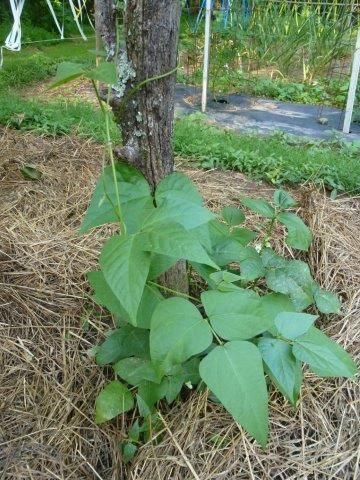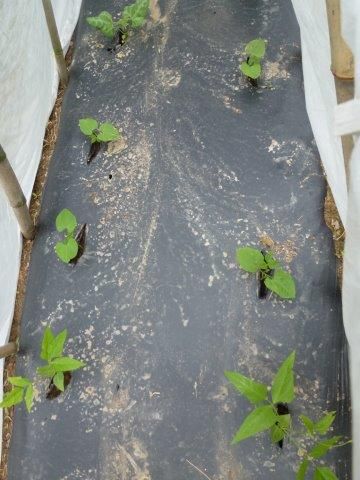
In my last post I wrote about pulses being the international crop of the year and said that I would talk about some beans to grow and sources for a variety of beans. Here’s a few that I have grown… and new ones for this growing season. I do save a lot of bean seed since it is easy to do–just let some pods mature and dry on the vine–then harvest them before pods open and seeds drop.
I’ve grown bush and runner beans and they both have their pros and cons. Bush beans are easier to grow in that you plant the seed in rows and they come up and grow into bushy plants about 1 1/2-to 2-feet tall. When beans are ready, one has to squat or kneel as they harvest down the row, often holding up the foliage to find the beans on the bottom of the plants, which can be gritty with soil since they are close to the earth. Pole beans are as easy to plant in rows, however they must be staked or grown on poles or trellises. It does take a bit of extra effort to create support for the beans, these can be simple stakes with string ties or more elaborate trellises. The advantages to supports are that the beans wind up around the poles and are easier to see and harvest and are free from dirt.
We have sort of a permanent bean area in the garden where we set four sturdy bean poles (small saplings). Every season, I string heavy garden twine horizontally, back and forth around the poles and then I weave some supports vertically up and down and plant the beans at the bottom of a piece of twine. Once they send out runners, I guide them to the twine and the beans take it from there. One year I tried A-frames from bamboo (sort of like an old-fashioned swingset) and used a plastic mesh grid–it worked–though I won’t use the plastic again since it isn’t biodegradable nor wildlife friendly. (Saved a large black snake tangled in it–it actually cut its flesh where it tried to slither through.) Bean tipis work well too and make a great place for kids to get in–or put a squash plant inside.
Since I am fond of edible flowers, for many years I have cultivated some beans just for their bloom. The ‘Scarlet Runner’ bean is one of my all-time favorites for both the scarlet flowers and green beans and ‘Painted Lady’ with her bi-color, red and white bloom eaten as a snap or shelled bean. I also like the ‘Purple Hyacinth Bean’ (Dolichos lablab is not a true Phaseolus) for its purple flowers and amazing purple pods. The latter can become a rather large plant and is very showy, however the pods are tough and not eaten, rather the beans should be shelled and need to be cooked before being eaten and they aren’t that good in flavor–so I grow them for the show.
Over the years, I have grown ‘Blue Lake’, ‘Kentucky Wonder’, ‘Golden Wax’, ‘Jade’, ‘Top Crop’, the broadbean ‘Romano’, ‘Chinese Long Bean’ and various others–and there hasn’t been a bean that I didn’t like. The most important thing about growing green beans is when to harvest them. It is best to get them young and tender or just at their peak–not tough. It can take just a day or two from tender to tough and once that happens, I prefer to shell them than eat a tough, stringy pod. At first I thought long beans would be tough because of thier appearance, however I really like long beans because they can be harvested from tender immature to peak size to even a little more than mature and can still be quite tasty; they have a longer window of harvest time than most green beans. Easily 18-inches long or more, I just cut them into whatever length needed for a recipe.
I have also cultivated ‘Fordhook’ limas, favas, chickpeas, cowpeas and soybeans. These beans are grown for shelling–not their pods–and can be eaten fresh or dried.
So this year, besides some old favorites, I have been inspired to try some new beans. The catalogs that I have been perusing are Vermont Bean Seed Company www.vermontbean.com; The Good Seed Catalog www.rareseeds.com; Native Seed Search www.nativeseedsearch.org; Seed Savers Exchange www.seedsavers.org; and Horizon Herbs www.horizonherbs.com. I’m trying to control myself–since there is a limited garden space–and one family only needs so many beans! The bean seeds alone are gorgeous–from creamy white to golden, yellow, red, brown and purple–not to mention speckled, mottled and multi-colored
Cultivar names and stories about seeds intrigue me. I am excited to find ‘Rattlesnake Snap’ (aka ‘Preacher Bean’) with a gorgeous mottled green and purple pod. And I have a long ‘Red Noodle Bean’ for snapping from Hudson Valley Seed Library–I wonder if it will remain red when cooked. The ‘Hidatsa Shield Figure’ is a beautiful two-tone white. golden and brown bean for shelling and drying; it was grown by Hidatsa tribe of North Dakota, described in Buffalo Bird Woman’s Garden and was the 2005 selection for Slow Foods’ Ark of Taste. The red-and white-speckled ‘Rouge Von Paris’ was first introduced at Paris Expo in 1854; it is for shelling fresh or dried. New to me, is an ancient crop from the Americas the ‘Lentil Bean’ as described in Baker Creek catalog: “Otherwise known among the Pennsylvania Dutch as Brown Lazy Wife, is perhaps one of the meatiest of all the old time pole beans.” How could I resist such a bean?
Bean dreaming… hope this inspires you to grow some beans. There are seed swaps coming up all around the country, which is a great place to procure some heirloom seeds. Meanwhile, I’m going to go put some beans to soak–it’s whats for dinner.
Check out these recipes featuring all sorts of legumes: /item/62635/recipes-featuring-pulses






















Comments
Log in or create an account to post a comment.
Sign up Log in